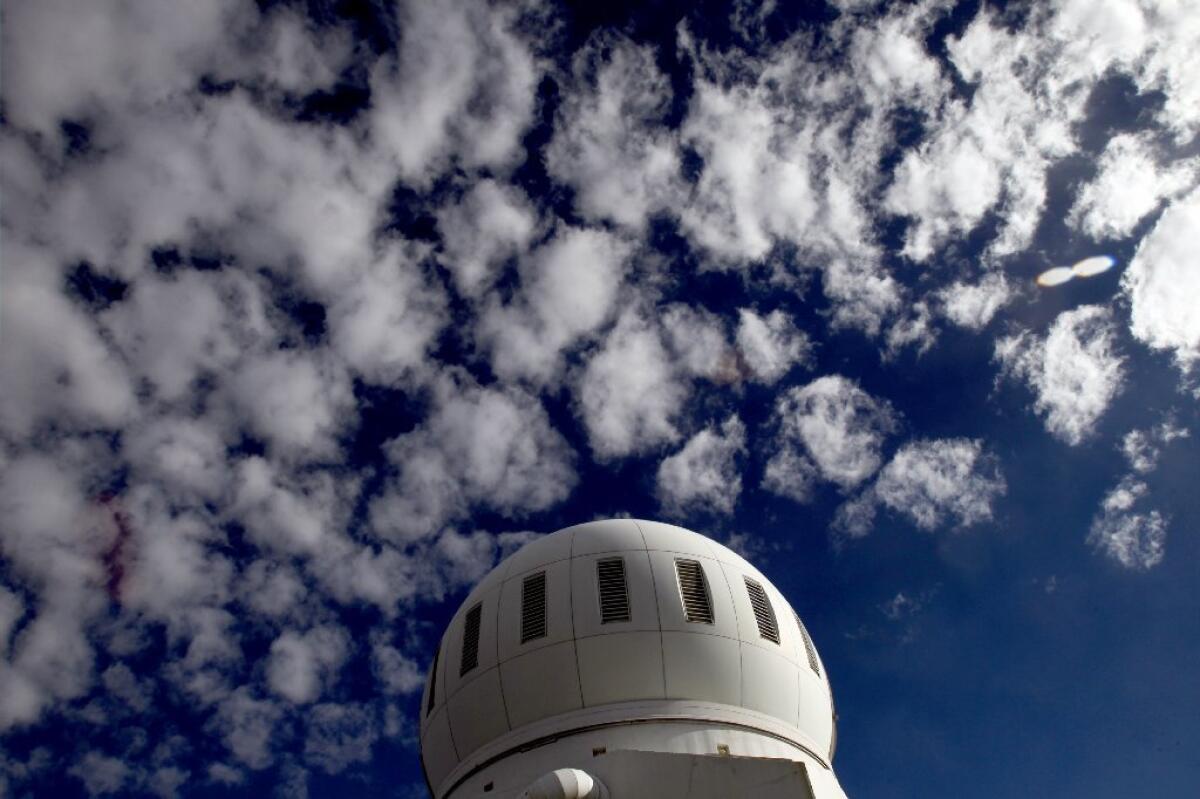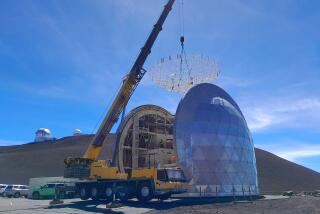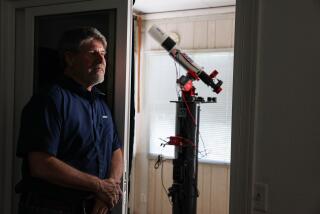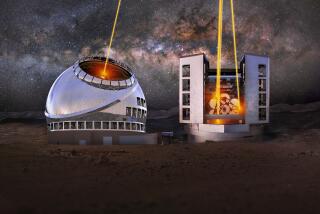Solar observatory in Big Bear grapples with prospect of being eclipsed

reporting from BIG BEAR LAKE, Calif. — Motors whirred as a gleaming white dome slowly opened, allowing one of the premier solar telescopes in the world to track the magnetic fields and exploding flares of the sun. In a few hours, computers would translate that data into detailed video and pictures of the sun’s turbulent surface.
Images captured weeks earlier already graced the monitors in a darkened control room at the Big Bear Solar Observatory. They revealed mysterious displays of dancing and flashing lights hovering between bubbles of solar plasma.
John Varsik, a research astronomer at the observatory perched high up in the San Bernardino Mountains, allowed a boyish grin to spread across his face. These lights “will be the focus of future research for years to come,” he said.
But Varsik, 57, will probably not be leading that research. The $6-million telescope completed in 2009 is already being eclipsed by a much bigger solar telescope under construction in Hawaii. Over the next five years, it will gradually shift to a new primary mission: operating as a test bed for new technology destined to be used elsewhere.
Around the country, many older solar telescopes are being shuttered to pay for a new generation of space-based observatories and the $360-million facility under construction atop Maui’s Haleakala Crater.
“In solar astronomy, as well as other areas of science, the cost of doing business has gone way up,” said Dale Gary, a solar physicist and director of the Big Bear telescope. “The only way to make that work is to shut down smaller operations or change their missions.”
With a 1.6-meter primary mirror, the Big Bear Solar Observatory is — for now — at the forefront of solar astronomy.
At the heart of its main telescope system is a computer-driven mirror that corrects the distortions caused by atmospheric turbulence due to moisture, wind or thin clouds. The surface of the 4-inch mirror is continually warped by 357 tiny computer-controlled pistons that create deformations about 1/50th as wide as a human hair, said Nicolas Gorceix, an optical engineer at the observatory.
Adding to the instrument’s precision is its location. The scope is built at the end of a jetty extending 800 feet into Big Bear Lake. Being surrounded by water reduces atmospheric convection.
Each day the sun shines, the telescope produces photos and video of solar activity that should help scientists make better predictions of the strength of solar storms associated with sunspot cycles.
The telescope was built with grants from NASA and the National Science Foundation, and the New Jersey Institute of Technology operates it on a $2-million annual budget largely funded by the federal government. Its staff of 15 — including about a dozen researchers and visiting scientists — have been investigating the complex dynamics of sunspots and seething plasma flows with unprecedented resolution.
Among their recent discoveries are the first detailed observations of “umbral spikes,” the clusters of long, cone-shaped filaments that appear in the darkest portion of sunspots, where magnetic fields are strongest. Spectral analysis of these filaments, which exist for only two to three minutes, suggests they are blasts of plasma along narrow magnetic tubes.
This is the type of work the Big Bear scientists most enjoy, but their priorities are already shifting. Their facility will increasingly serve as a test bed for cutting-edge instrumentation technologies that will be used at the Daniel K. Inouye Solar Telescope in Hawaii, which is set to begin operations in 2019. That means some of the astronomical research positions now in Big Bear may be replaced by engineering jobs.
Until then, the astronomers plan to set aside as much time as possible for research on the sun’s menagerie of electromagnetic forces. Of particular concern are solar storms that can hurl blasts of radioactive particles, X-rays and magnetic energy toward Earth.
Such floods of charged plasma particles can disrupt the network of global positioning system satellites, knock out communications to transoceanic flights, fry sensitive satellite equipment in orbit and expose astronauts to dangerous doses of radiation.
They can also darken cities by overloading grids with electricity. A solar storm in 1989 knocked out power in Canada’s Quebec province for more than nine hours and caused an estimated $2 billion in damage.
In 1859, a solar storm quieted the communications technology of the day: the telegraph.
The National Science Foundation’s decision to shift its resources to space-based solar telescopes and the Hawaii observatory has led to greater division between the haves and have-nots in the solar astronomical community.
Giant solar facilities, including a 150-foot tower atop Mt. Wilson in the San Gabriel Mountains above Pasadena, have deteriorated into “backwaters that have become hard to support,” lamented UCLA astronomer Roger Ulrich, who is struggling to keep the facility in operation.
The Mt. Wilson magnetograph — an instrument that makes detailed observations of the sun’s magnetic fields — was shut down in 2013, a year after its tower received a new coat of paint funded with a $1.5-million grant from the NSF.
“Big science projects have fun times and not-so-fun times,” said Ulrich, who used the magnetograph to study the solar interior. “Right now, I have no backup funding from the University of California and have had difficulty in maintaining a series of grants from NASA and the NSF.”
Elsewhere, the National Solar Observatory is scaling down operations at its huge McMath-Pierce Solar Telescope on Kitt Peak, Ariz., and its Richard B. Dunn Solar Telescope on Sacramento Peak, N.M.
The ultimate fate of both telescopes remains uncertain, although efforts are underway to hand off control to groups of community colleges, private donors and other agencies. The instruments were inaugurated in the 1960s and 1970s when unusually intense solar storms were bombarding the atmosphere with radiation potentially harmful to satellites and astronauts.
“Solar astronomy is a tightknit community,” said Claude Plymate, chief observer at the Big Bear observatory. “We grieve the loss of all these telescopes.”
Valentin M. Pillet, director of the National Solar Observatory in Boulder, Colo., said he feels the loss as well.
“We’d love to maintain these facilities if we could,” Pillet said. “But the way technology evolves, things that were competitive years ago are no longer competitive.”
Twitter: @LouisSahagun







